Analyzing the Three Waves of Feminist Movements in Canadian Politics
VerifiedAdded on 2022/09/23
|6
|1384
|24
Essay
AI Summary
This essay provides an overview of the feminist movements in Canada, focusing on the three distinct waves of activism. It explores the political, social, and economic factors that shaped these movements, highlighting their goals, achievements, and failures. The first wave, primarily concerned with voting rights, is contrasted with the second wave, which aimed for broader social and legal equality, and the third wave, which addressed intersectionality and challenged previous ideologies. The essay analyzes the successes and limitations of each wave, considering the impact on Canadian society and the ongoing struggle for women's rights. It also discusses the significance of key concepts such as "The Personal is Political" and the challenges faced by women in achieving equal rights and opportunities.
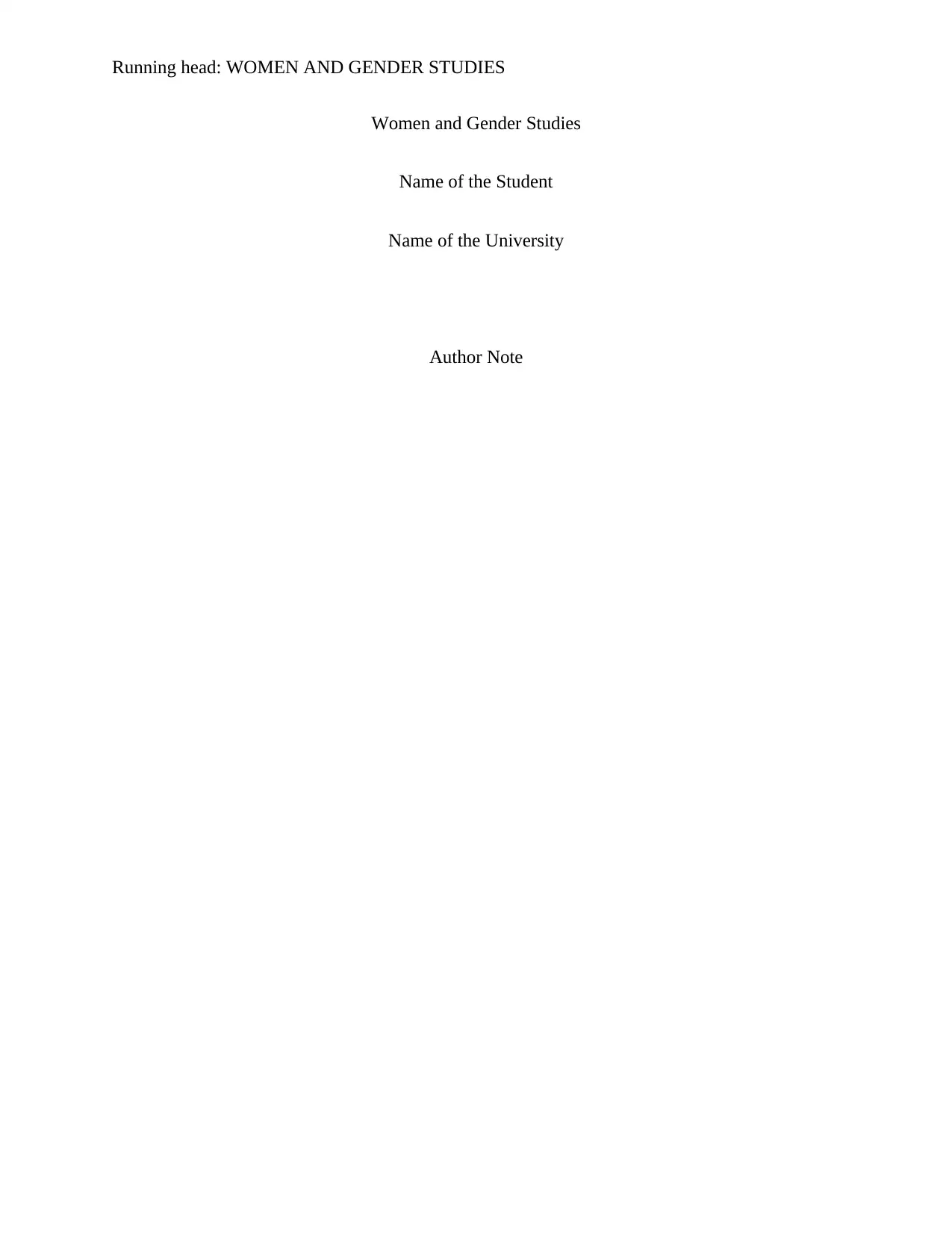
Running head: WOMEN AND GENDER STUDIES
Women and Gender Studies
Name of the Student
Name of the University
Author Note
Women and Gender Studies
Name of the Student
Name of the University
Author Note
Paraphrase This Document
Need a fresh take? Get an instant paraphrase of this document with our AI Paraphraser
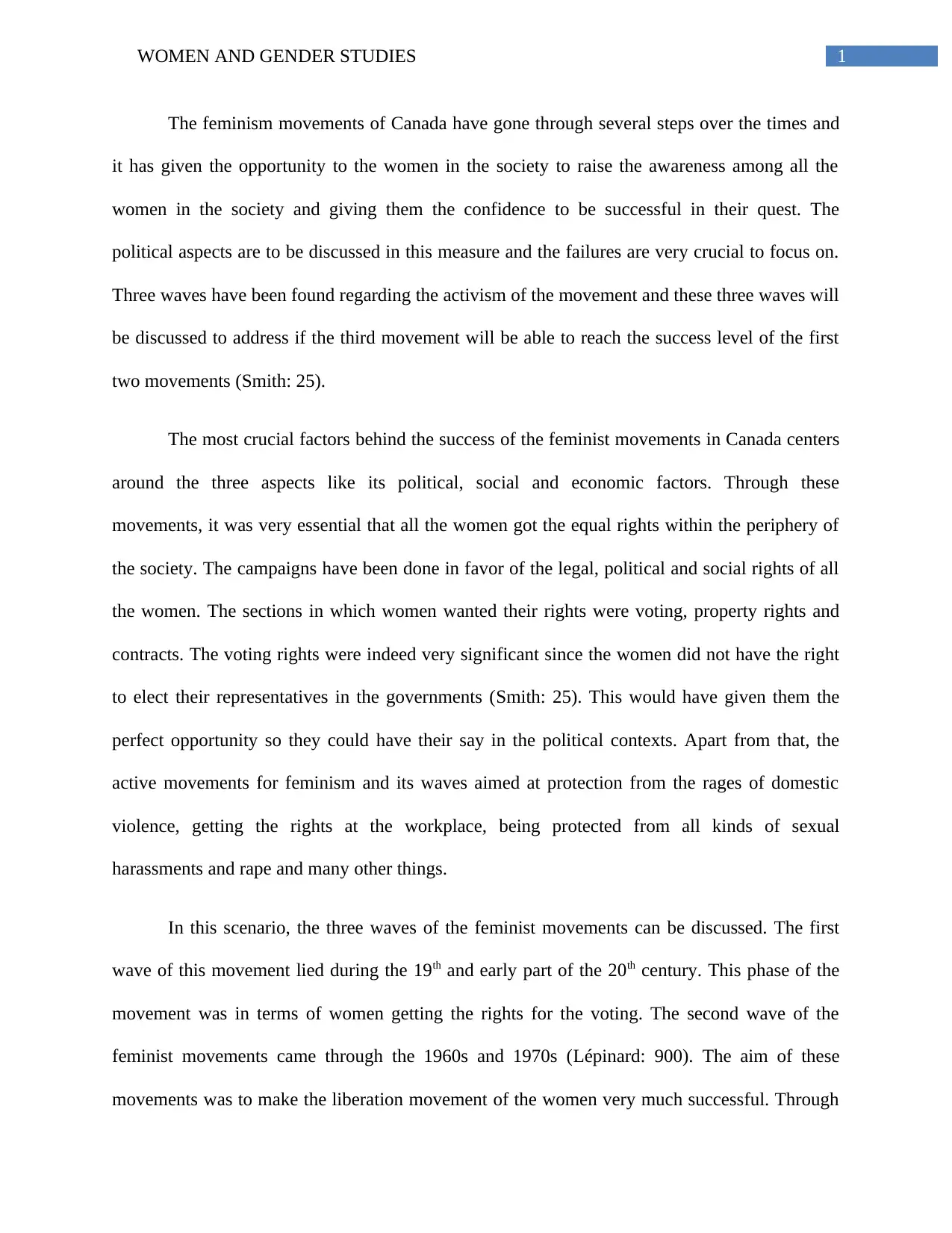
1WOMEN AND GENDER STUDIES
The feminism movements of Canada have gone through several steps over the times and
it has given the opportunity to the women in the society to raise the awareness among all the
women in the society and giving them the confidence to be successful in their quest. The
political aspects are to be discussed in this measure and the failures are very crucial to focus on.
Three waves have been found regarding the activism of the movement and these three waves will
be discussed to address if the third movement will be able to reach the success level of the first
two movements (Smith: 25).
The most crucial factors behind the success of the feminist movements in Canada centers
around the three aspects like its political, social and economic factors. Through these
movements, it was very essential that all the women got the equal rights within the periphery of
the society. The campaigns have been done in favor of the legal, political and social rights of all
the women. The sections in which women wanted their rights were voting, property rights and
contracts. The voting rights were indeed very significant since the women did not have the right
to elect their representatives in the governments (Smith: 25). This would have given them the
perfect opportunity so they could have their say in the political contexts. Apart from that, the
active movements for feminism and its waves aimed at protection from the rages of domestic
violence, getting the rights at the workplace, being protected from all kinds of sexual
harassments and rape and many other things.
In this scenario, the three waves of the feminist movements can be discussed. The first
wave of this movement lied during the 19th and early part of the 20th century. This phase of the
movement was in terms of women getting the rights for the voting. The second wave of the
feminist movements came through the 1960s and 1970s (Lépinard: 900). The aim of these
movements was to make the liberation movement of the women very much successful. Through
The feminism movements of Canada have gone through several steps over the times and
it has given the opportunity to the women in the society to raise the awareness among all the
women in the society and giving them the confidence to be successful in their quest. The
political aspects are to be discussed in this measure and the failures are very crucial to focus on.
Three waves have been found regarding the activism of the movement and these three waves will
be discussed to address if the third movement will be able to reach the success level of the first
two movements (Smith: 25).
The most crucial factors behind the success of the feminist movements in Canada centers
around the three aspects like its political, social and economic factors. Through these
movements, it was very essential that all the women got the equal rights within the periphery of
the society. The campaigns have been done in favor of the legal, political and social rights of all
the women. The sections in which women wanted their rights were voting, property rights and
contracts. The voting rights were indeed very significant since the women did not have the right
to elect their representatives in the governments (Smith: 25). This would have given them the
perfect opportunity so they could have their say in the political contexts. Apart from that, the
active movements for feminism and its waves aimed at protection from the rages of domestic
violence, getting the rights at the workplace, being protected from all kinds of sexual
harassments and rape and many other things.
In this scenario, the three waves of the feminist movements can be discussed. The first
wave of this movement lied during the 19th and early part of the 20th century. This phase of the
movement was in terms of women getting the rights for the voting. The second wave of the
feminist movements came through the 1960s and 1970s (Lépinard: 900). The aim of these
movements was to make the liberation movement of the women very much successful. Through
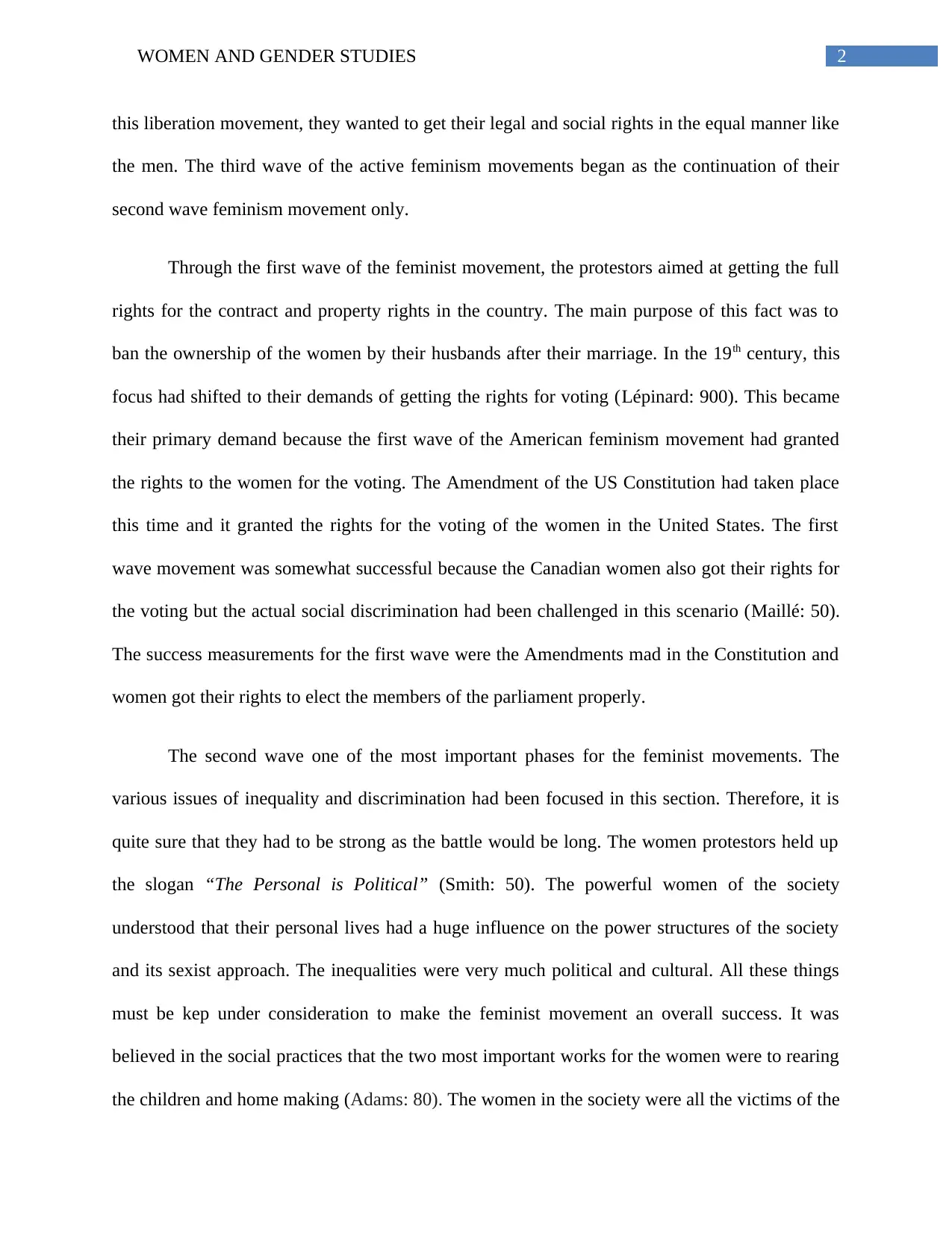
2WOMEN AND GENDER STUDIES
this liberation movement, they wanted to get their legal and social rights in the equal manner like
the men. The third wave of the active feminism movements began as the continuation of their
second wave feminism movement only.
Through the first wave of the feminist movement, the protestors aimed at getting the full
rights for the contract and property rights in the country. The main purpose of this fact was to
ban the ownership of the women by their husbands after their marriage. In the 19th century, this
focus had shifted to their demands of getting the rights for voting (Lépinard: 900). This became
their primary demand because the first wave of the American feminism movement had granted
the rights to the women for the voting. The Amendment of the US Constitution had taken place
this time and it granted the rights for the voting of the women in the United States. The first
wave movement was somewhat successful because the Canadian women also got their rights for
the voting but the actual social discrimination had been challenged in this scenario (Maillé: 50).
The success measurements for the first wave were the Amendments mad in the Constitution and
women got their rights to elect the members of the parliament properly.
The second wave one of the most important phases for the feminist movements. The
various issues of inequality and discrimination had been focused in this section. Therefore, it is
quite sure that they had to be strong as the battle would be long. The women protestors held up
the slogan “The Personal is Political” (Smith: 50). The powerful women of the society
understood that their personal lives had a huge influence on the power structures of the society
and its sexist approach. The inequalities were very much political and cultural. All these things
must be kep under consideration to make the feminist movement an overall success. It was
believed in the social practices that the two most important works for the women were to rearing
the children and home making (Adams: 80). The women in the society were all the victims of the
this liberation movement, they wanted to get their legal and social rights in the equal manner like
the men. The third wave of the active feminism movements began as the continuation of their
second wave feminism movement only.
Through the first wave of the feminist movement, the protestors aimed at getting the full
rights for the contract and property rights in the country. The main purpose of this fact was to
ban the ownership of the women by their husbands after their marriage. In the 19th century, this
focus had shifted to their demands of getting the rights for voting (Lépinard: 900). This became
their primary demand because the first wave of the American feminism movement had granted
the rights to the women for the voting. The Amendment of the US Constitution had taken place
this time and it granted the rights for the voting of the women in the United States. The first
wave movement was somewhat successful because the Canadian women also got their rights for
the voting but the actual social discrimination had been challenged in this scenario (Maillé: 50).
The success measurements for the first wave were the Amendments mad in the Constitution and
women got their rights to elect the members of the parliament properly.
The second wave one of the most important phases for the feminist movements. The
various issues of inequality and discrimination had been focused in this section. Therefore, it is
quite sure that they had to be strong as the battle would be long. The women protestors held up
the slogan “The Personal is Political” (Smith: 50). The powerful women of the society
understood that their personal lives had a huge influence on the power structures of the society
and its sexist approach. The inequalities were very much political and cultural. All these things
must be kep under consideration to make the feminist movement an overall success. It was
believed in the social practices that the two most important works for the women were to rearing
the children and home making (Adams: 80). The women in the society were all the victims of the
⊘ This is a preview!⊘
Do you want full access?
Subscribe today to unlock all pages.

Trusted by 1+ million students worldwide
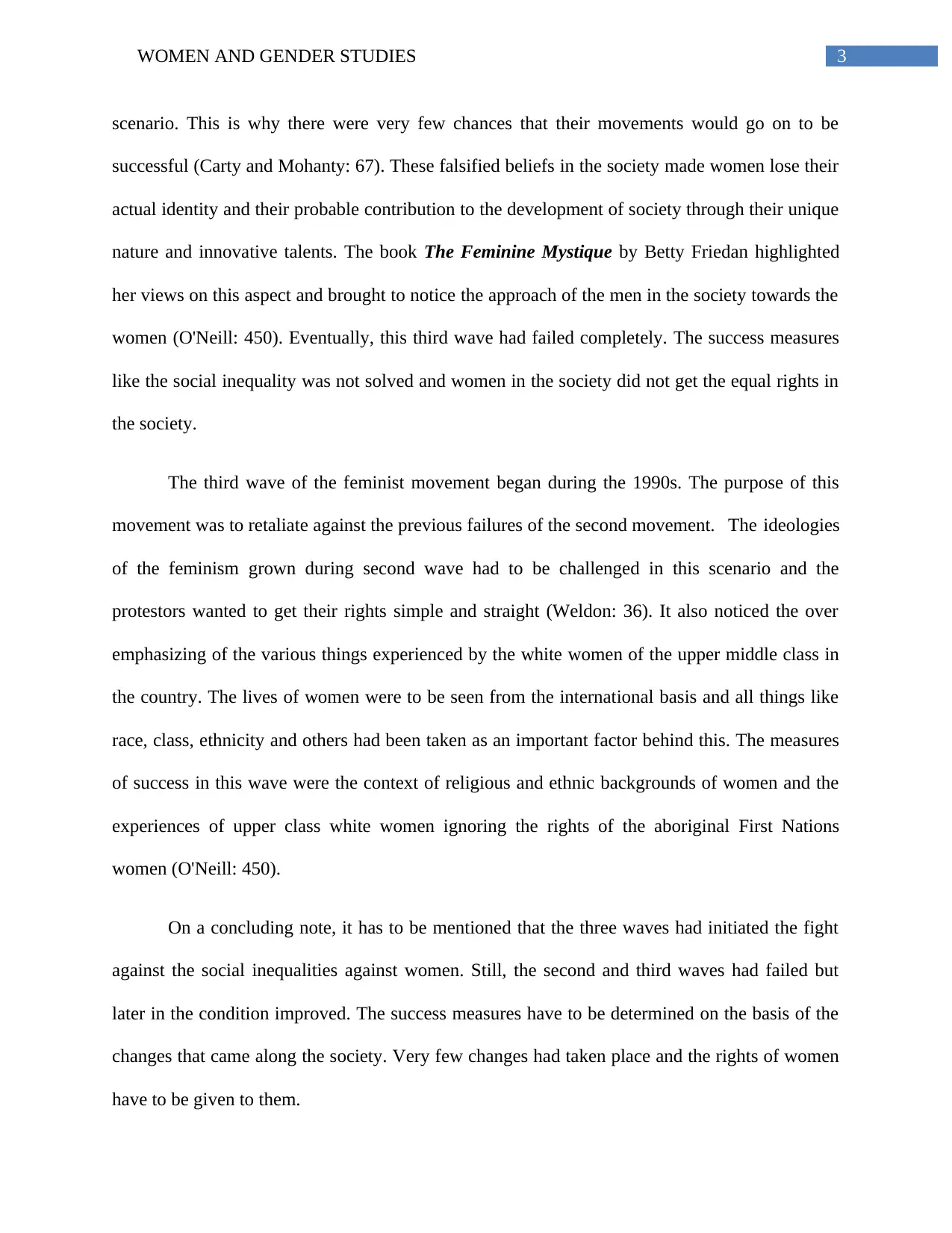
3WOMEN AND GENDER STUDIES
scenario. This is why there were very few chances that their movements would go on to be
successful (Carty and Mohanty: 67). These falsified beliefs in the society made women lose their
actual identity and their probable contribution to the development of society through their unique
nature and innovative talents. The book The Feminine Mystique by Betty Friedan highlighted
her views on this aspect and brought to notice the approach of the men in the society towards the
women (O'Neill: 450). Eventually, this third wave had failed completely. The success measures
like the social inequality was not solved and women in the society did not get the equal rights in
the society.
The third wave of the feminist movement began during the 1990s. The purpose of this
movement was to retaliate against the previous failures of the second movement. The ideologies
of the feminism grown during second wave had to be challenged in this scenario and the
protestors wanted to get their rights simple and straight (Weldon: 36). It also noticed the over
emphasizing of the various things experienced by the white women of the upper middle class in
the country. The lives of women were to be seen from the international basis and all things like
race, class, ethnicity and others had been taken as an important factor behind this. The measures
of success in this wave were the context of religious and ethnic backgrounds of women and the
experiences of upper class white women ignoring the rights of the aboriginal First Nations
women (O'Neill: 450).
On a concluding note, it has to be mentioned that the three waves had initiated the fight
against the social inequalities against women. Still, the second and third waves had failed but
later in the condition improved. The success measures have to be determined on the basis of the
changes that came along the society. Very few changes had taken place and the rights of women
have to be given to them.
scenario. This is why there were very few chances that their movements would go on to be
successful (Carty and Mohanty: 67). These falsified beliefs in the society made women lose their
actual identity and their probable contribution to the development of society through their unique
nature and innovative talents. The book The Feminine Mystique by Betty Friedan highlighted
her views on this aspect and brought to notice the approach of the men in the society towards the
women (O'Neill: 450). Eventually, this third wave had failed completely. The success measures
like the social inequality was not solved and women in the society did not get the equal rights in
the society.
The third wave of the feminist movement began during the 1990s. The purpose of this
movement was to retaliate against the previous failures of the second movement. The ideologies
of the feminism grown during second wave had to be challenged in this scenario and the
protestors wanted to get their rights simple and straight (Weldon: 36). It also noticed the over
emphasizing of the various things experienced by the white women of the upper middle class in
the country. The lives of women were to be seen from the international basis and all things like
race, class, ethnicity and others had been taken as an important factor behind this. The measures
of success in this wave were the context of religious and ethnic backgrounds of women and the
experiences of upper class white women ignoring the rights of the aboriginal First Nations
women (O'Neill: 450).
On a concluding note, it has to be mentioned that the three waves had initiated the fight
against the social inequalities against women. Still, the second and third waves had failed but
later in the condition improved. The success measures have to be determined on the basis of the
changes that came along the society. Very few changes had taken place and the rights of women
have to be given to them.
Paraphrase This Document
Need a fresh take? Get an instant paraphrase of this document with our AI Paraphraser
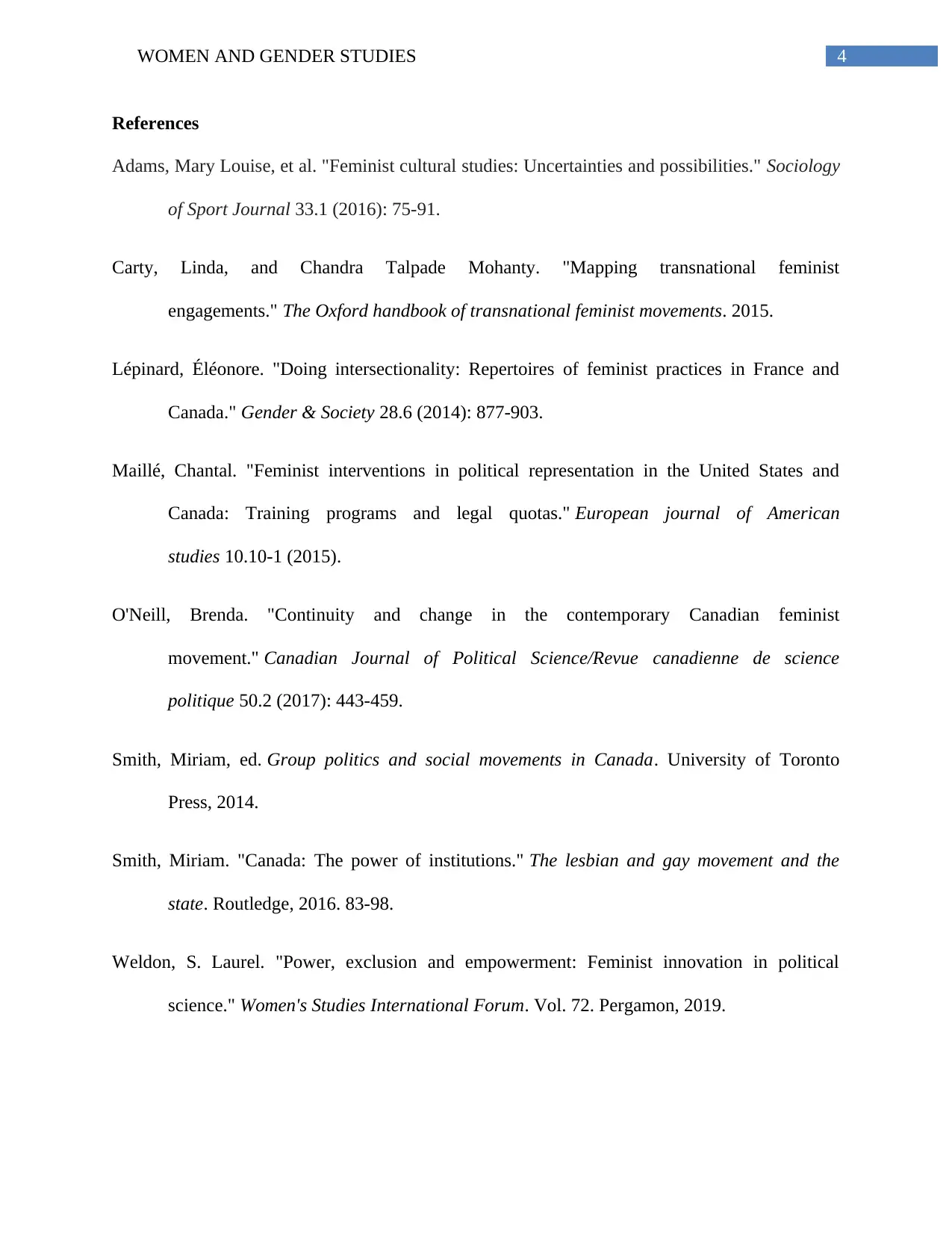
4WOMEN AND GENDER STUDIES
References
Adams, Mary Louise, et al. "Feminist cultural studies: Uncertainties and possibilities." Sociology
of Sport Journal 33.1 (2016): 75-91.
Carty, Linda, and Chandra Talpade Mohanty. "Mapping transnational feminist
engagements." The Oxford handbook of transnational feminist movements. 2015.
Lépinard, Éléonore. "Doing intersectionality: Repertoires of feminist practices in France and
Canada." Gender & Society 28.6 (2014): 877-903.
Maillé, Chantal. "Feminist interventions in political representation in the United States and
Canada: Training programs and legal quotas." European journal of American
studies 10.10-1 (2015).
O'Neill, Brenda. "Continuity and change in the contemporary Canadian feminist
movement." Canadian Journal of Political Science/Revue canadienne de science
politique 50.2 (2017): 443-459.
Smith, Miriam, ed. Group politics and social movements in Canada. University of Toronto
Press, 2014.
Smith, Miriam. "Canada: The power of institutions." The lesbian and gay movement and the
state. Routledge, 2016. 83-98.
Weldon, S. Laurel. "Power, exclusion and empowerment: Feminist innovation in political
science." Women's Studies International Forum. Vol. 72. Pergamon, 2019.
References
Adams, Mary Louise, et al. "Feminist cultural studies: Uncertainties and possibilities." Sociology
of Sport Journal 33.1 (2016): 75-91.
Carty, Linda, and Chandra Talpade Mohanty. "Mapping transnational feminist
engagements." The Oxford handbook of transnational feminist movements. 2015.
Lépinard, Éléonore. "Doing intersectionality: Repertoires of feminist practices in France and
Canada." Gender & Society 28.6 (2014): 877-903.
Maillé, Chantal. "Feminist interventions in political representation in the United States and
Canada: Training programs and legal quotas." European journal of American
studies 10.10-1 (2015).
O'Neill, Brenda. "Continuity and change in the contemporary Canadian feminist
movement." Canadian Journal of Political Science/Revue canadienne de science
politique 50.2 (2017): 443-459.
Smith, Miriam, ed. Group politics and social movements in Canada. University of Toronto
Press, 2014.
Smith, Miriam. "Canada: The power of institutions." The lesbian and gay movement and the
state. Routledge, 2016. 83-98.
Weldon, S. Laurel. "Power, exclusion and empowerment: Feminist innovation in political
science." Women's Studies International Forum. Vol. 72. Pergamon, 2019.

5WOMEN AND GENDER STUDIES
⊘ This is a preview!⊘
Do you want full access?
Subscribe today to unlock all pages.

Trusted by 1+ million students worldwide
1 out of 6
Related Documents
Your All-in-One AI-Powered Toolkit for Academic Success.
+13062052269
info@desklib.com
Available 24*7 on WhatsApp / Email
![[object Object]](/_next/static/media/star-bottom.7253800d.svg)
Unlock your academic potential
Copyright © 2020–2025 A2Z Services. All Rights Reserved. Developed and managed by ZUCOL.





